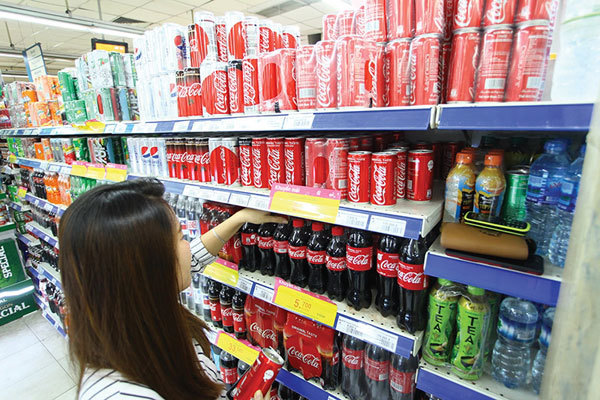 |
| Many beverage groups covering water, iced tea, soft drinks, and more are enjoying rising revenues. VIR Photo: Le Toan |
In late March, Masan Consumer Holdings, a member of Masan Group, officially inaugurated a complex with the total investment capital of nearly $70 million, located in the southern province of Hau Giang. Covering an area of 10 hectares at Hau River Industrial Zone, the complex is able to put out 180 million litres of soft drinks per year in collaboration with other products such as instant noodles and rice fibre items.
Masan Consumer Holdings’ plant in Hau Giang is part of its strategy to invest in and expand nationwide production systems to optimise logistics costs. Besides that, it will help the company realise the target of doubling revenues in terms of the beverage segment this year.
In 2020, the company acquired $161.7 million in revenues from the segment, up 5 per cent on-year, with the major contribution of energy drinks. Notably, its Wake-Up 247 coffee-flavoured energy drink garnered revenues of $87 million and made up 10 per cent of energy drink market share. Compact Cherry products, meanwhile, reported an increase of 81 per cent in revenues on-year, with market share of 1 per cent.
Masan Consumer’s impressive growth is demonstrating the potential of the beverage market and especially soft drinks in Vietnam, with the group not yet even in the top three largest beverage producers in the country.
Attaining profits
According to a report published by Vietnam Credit in 2020, the beverage market is dominated by Coca-Cola and PepsiCo, which take up around 64 per cent of the market share; followed by domestic players like Tan Hiep Phat Beverage Group. All have reported rocketing increases in revenue.
Suntory PepsiCo Vietnam earned $796 million in revenues in 2019, up $100 million on-year. Its success is thanks to its wide portfolio of popular brands in the soft drinks market, such as Aquafina, Tea+, Twister, Sting, Pepsi, and 7-Up.
Global soft drinks giant Coca-Cola follows with revenues of $404 million in the same period, and Tan Hiep Phat at $400 million and focusing on tea and energy drinks. Another giant from the Philippines, URC, holds fourth place with more than $304 million in sales.
TCPVN, the first international office in Vietnam for TCP Group, acquired $43.5 million from the Vietnamese market thanks to its only product here, energy drink Red Bull.
Regarding profits, the Tan Hiep Phat complex’s profit has increased steadily over the years, but in 2019 it jumped 65 per cent from $87 million to $143.5 million thanks to an important contribution from a new Number One Chu Lai factory. In that time, PepsiCo Vietnam attained just over $160 million in profits.
Growth in the beverage industry is forecast to maintain an annual increase of 7 per cent – a large rise compared to the average increase of 2 per cent for the likes of France or Japan, according to statistics published by the Vietnam Beer-Alcohol-Beverage Association (VBA). With the most rapid growth seen in the fast-moving consumer goods industry, the volume sales of soft drinks and carbonated soft drinks in Vietnam was estimated to likely reach 3.3 billion and 1.5 billion litres in 2020, respectively.
The VBA statistics showed that 85 per cent of the annual production and consumption of the Vietnamese beverage market come from soft drinks, instant teas, fruit juices, and energy drinks. The association expects that the output of soft drinks will reach from 8.3 billion litres to 9.2 billion litres per year.
According to Tran Qui Thanh, CEO and founder of Tan Hiep Phat, the group sells more than one billion litres of beverages per year including herbal green tea, energy drinks, mineral water, and soy milk in the domestic market and exports to 16 countries. The sales figures are expected to triple in the next five years, which also serve for export.
“In the early days of establishment, the group had only 20 employees and the capacity was approximately one million litres of beverages a year, 3,000 bottles a day. Currently, the group has more than 4,000 employees, providing the market with more than one billion litres per year,” said Thanh.
By 2023, the group expects to make more than three billion litres of beverages per year.
Investment ahead
Masan Consumer expects that its revenues from energy drinks will touch $217 million of the $304 million total revenue in terms of the company’s beverage segment as a whole. The company sets the target to balance its revenues from the food and beverage sector at 50 per cent each by 2025.
In a meeting with former Prime Minister Nguyen Xuan Phuc in 2018, president of Coca-Cola’s Bottling Investments Group Calin Dragan said that the corporation was looking for areas in Hanoi to build a fourth factory in Vietnam, while simultaneously planning to open an additional factory in Ho Chi Minh City in 2020. However, the pandemic developments seem to have put such plans on hold for now.
The project in Hanoi was set for the total investment of $300 million, which would produce both traditional and nutritious products with higher added value using local materials, while generating jobs for thousands of direct and indirect labourers and developing a distribution network. Coca-Cola Vietnam first started investment in the country with a venture in Hanoi in 1994.
In the context of pandemic impacts, many businesses in the beverage industry are taking advantage to accelerate investment in innovation from the distribution system and adjusting the proportion between traditional and modern channels; developing applications to enhance customer experience; transforming packaging design; and developing product lines to strengthen resistance and the immune system for consumers, among others.
Nguyen Dang Quang, chairman of Masan Group, said that in difficult times many food businesses are pioneering in finding solutions and new directions to be ready to overcome the pandemic.
|
Non-alcoholic drinks in close relation with disease and obesity The ballooning increase in both revenues and profit of beverage producers is an upside for the beverage industry, but the downside could be an increase in obesity and other non-contagious diseases. A report from the Vietnam Beer-Alcohol-Beverage Association shows that the consumption of beverages per capita in Vietnam is 23 litres per year. Vietnamese people are adding more sugar from beverages into their bodies. Huynh Nam Phuong, deputy director of the Vietnam’s Food and Nutrition Training Centre, under the National Institute of Nutrition (NIN) said that the amount of sugar in energy drinks is 24 grammes per 250ml can; meanwhile, a 600ml soft drink can contain approximately 36 grammes. Drinking one can of carbonated soft drink per day can cause a person to increase weight by nearly 7kg in a year. In addition, the main components of carbonated soft drinks are flavouring, sweeteners, and preservatives which are not good for nutritional health. Following ingredient content labels on non-alcoholic beverages, the sugar volume in almost all of bottles and cans of non-alcoholic beverages, especially energy drinks, exceed the recommendations of the World Health Organization (WHO). For example, one serving of a 330ml Sting energy drink bottle contains 63.4 grammes of sugar, nearly triple the level of WHO’s recommendation. The sugar content of a 390ml Pepsi is 41 grammes and 390ml Mountain Dew is 62.5 grammes. Last month, the NIN published National General Nutrition Survey for 2019-2020, highlighting alarming increases in the number of obese and overweight children across the country. The survey was the largest of its kind in Vietnam and involved over 22,000 households in 25 cities and provinces representing six ecological areas. It collected anthropometric data as well as data on micro-nutrients, individual food portions, food security, and food hygiene and safety. The survey showed that the rate of overweight and obese school-age children (5-19 years old) increased from 8.5 per cent in 2010 to 19.0 per cent in 2020. Within this figure, the rate reached 26.8 per cent in urban areas and 18.3 per cent in rural areas. The WHO’s study shows that on average, a single can of a sugary drink contains around 40 grammes of free sugars (equivalent to around 10 teaspoons of table sugar). Over-consumption of sugar is a major contributor to obesity, diabetes, and tooth decay. The percentage of adolescents who drink soft drinks daily in Vietnam is around 20 per cent. “Drinking too much soft drinks is one reason causing overweight and obese, especially in children. These are problems for both the economy and the health sector. Along with the impact on intellectual development, overweight and obese children often lack confidence. Their receptive ability at school is also limited, thus it may cause unexpected affects when they grow up,” Phuong said. |
VIR

Media tycoon has no way out after suffering losses
The VN-Index has been in the top of the world's strongest stock indexes since the beginning of the year with an increase of more than 16%. Over the past year, the index has increased by nearly 50% despite the Covid-19 pandemic.

Vietnam beverage industry potential appeals to foreign players
Listed among leading Asian consumers of alcoholic drinks, Vietnam remains potential for foreign investors.